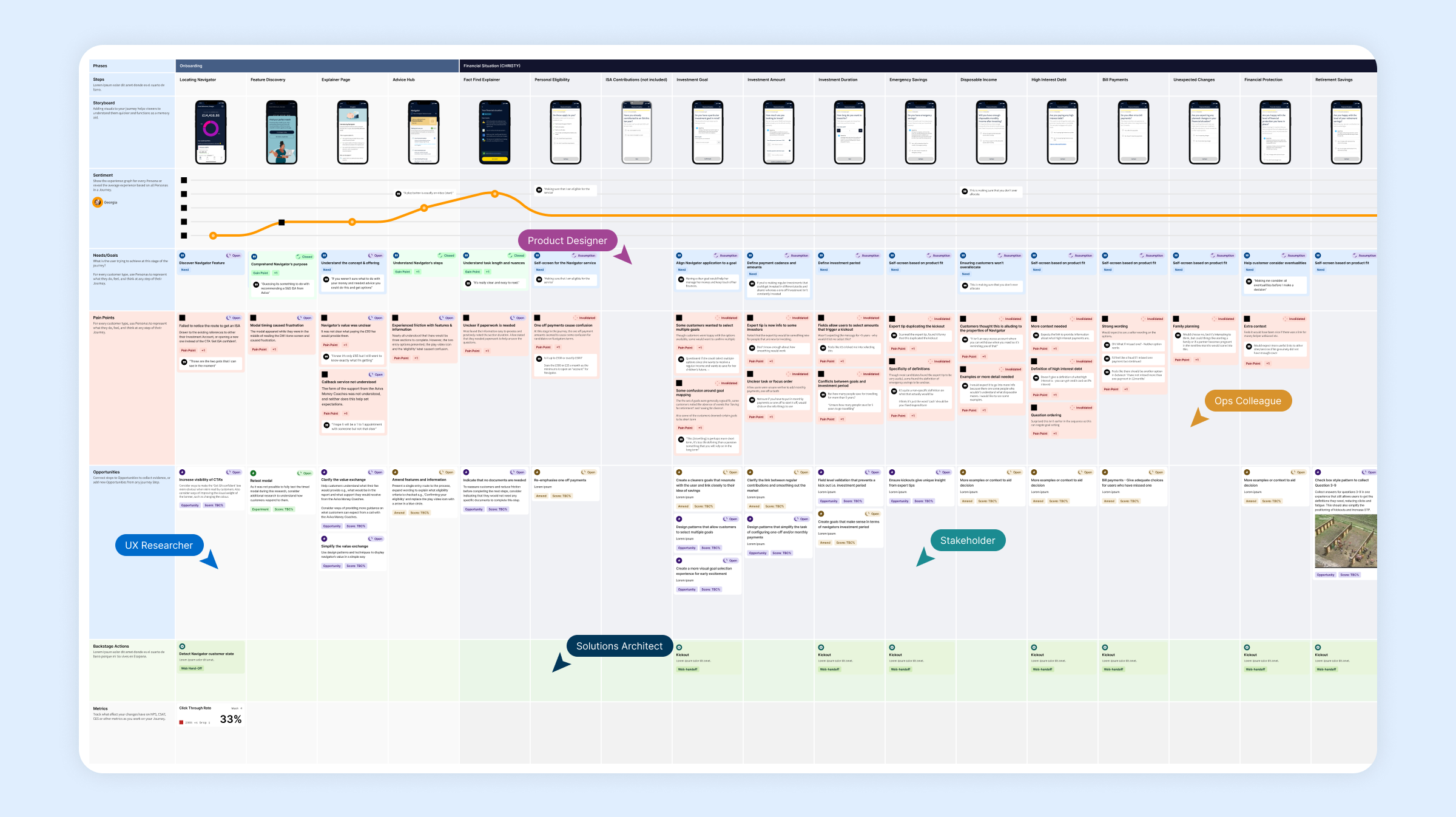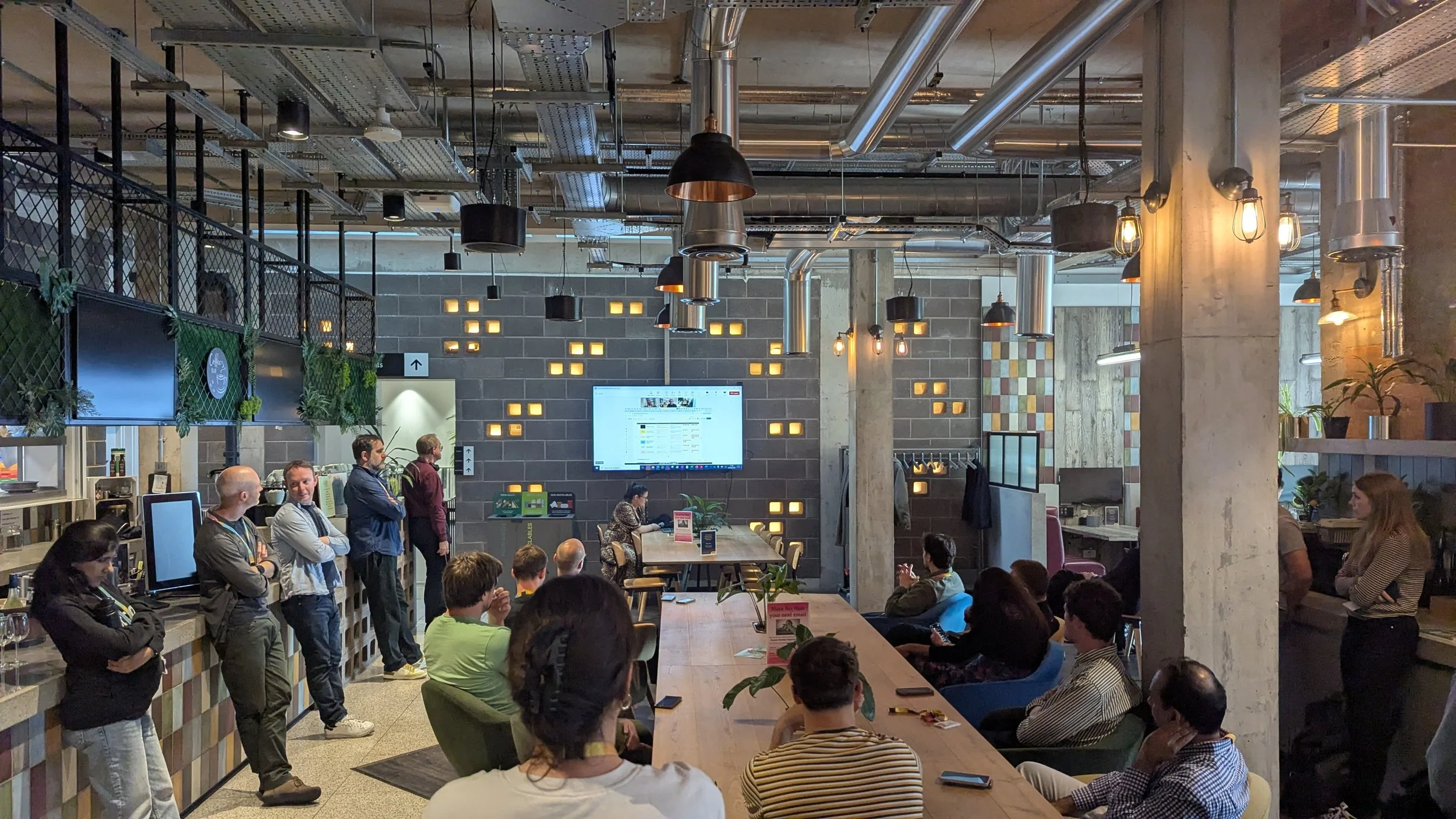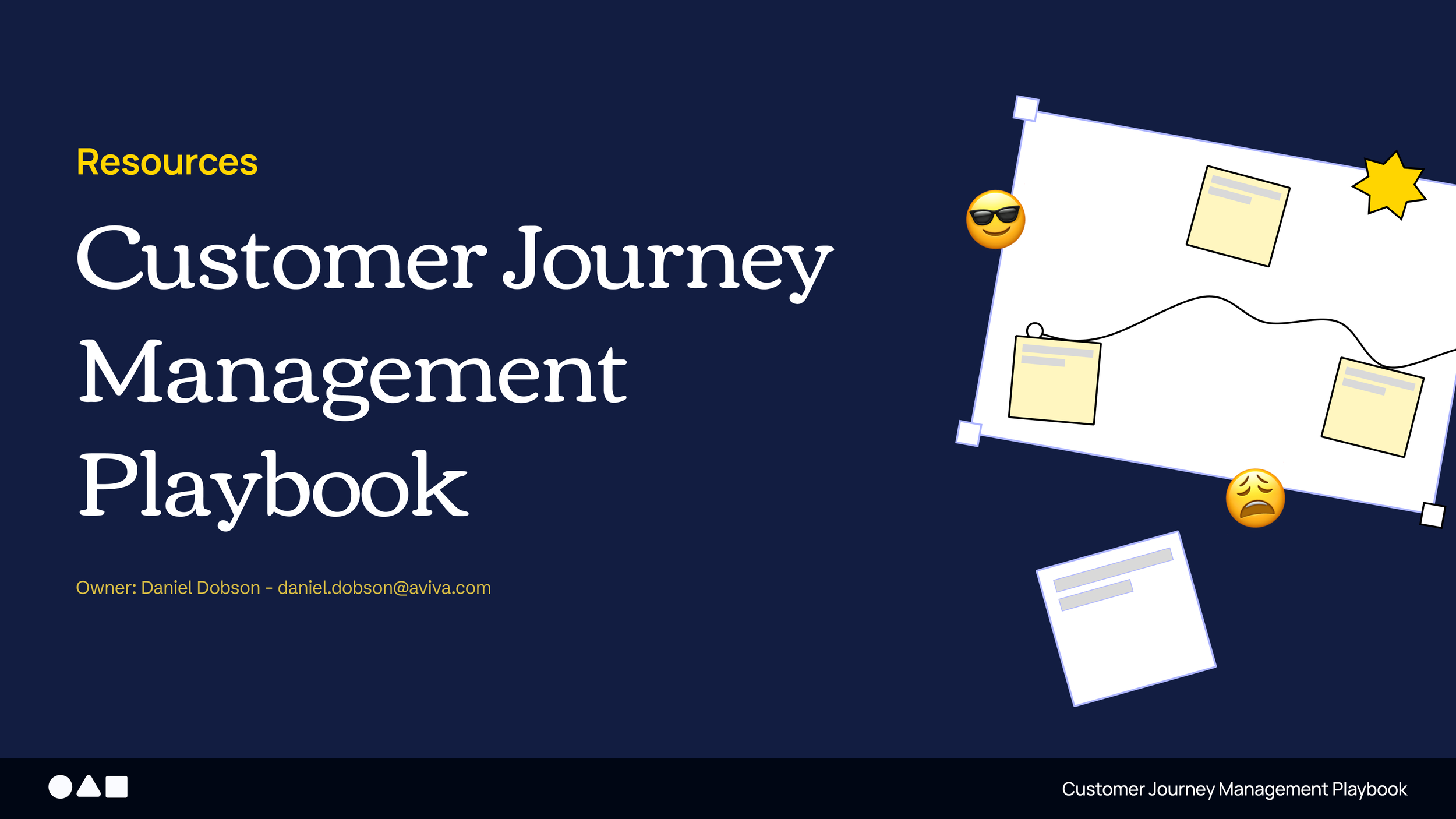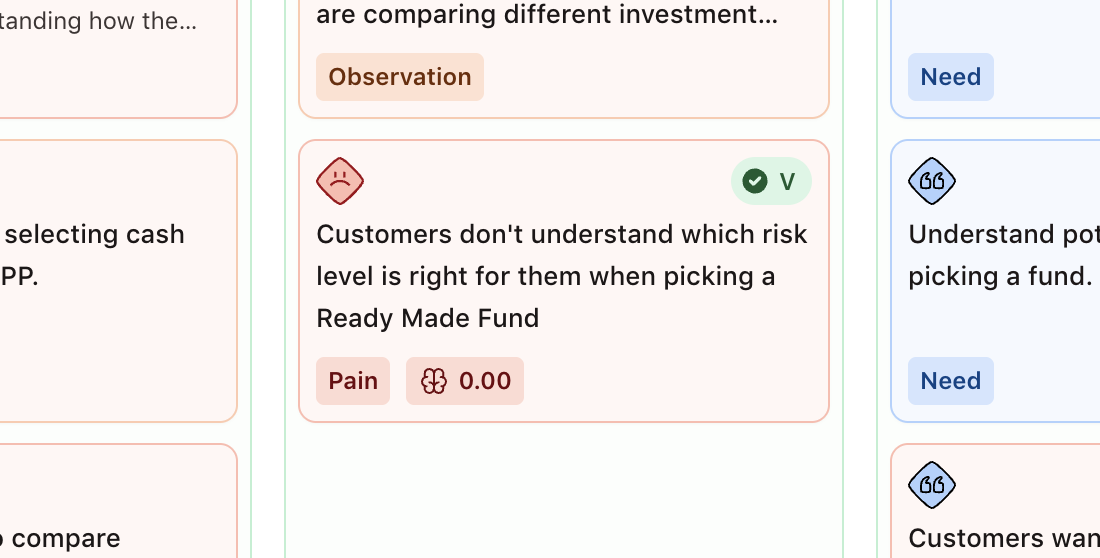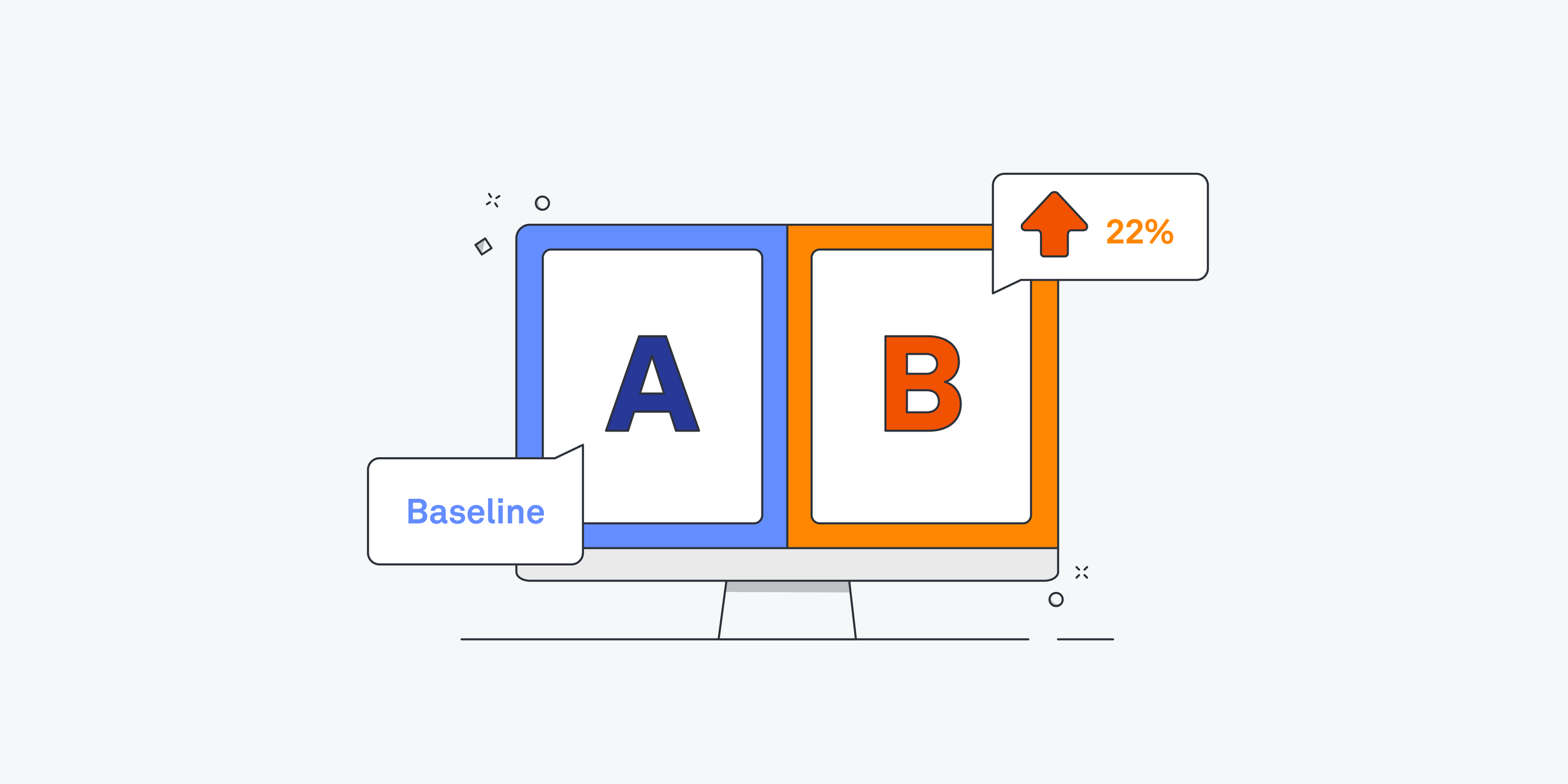CASE STUDY
Embedding Journey Management practices within teams to optimise existing journeys and unlock growth.
Role
Lead Product Designer
Date
September 2024 - Present
Skills
Service Design, Journey Management, Customer Experience
Project Summary.
View Journey Management Templates
Following a period of intense delivery, launching numerous propositions and re-platforming key journeys for customers - a shift needed to ensure we were monitoring and optimising these new customer experiences. Alongside continuous delivery, this transformation was tied to an ambitious £50m growth target to improve our existing digital journeys and resulted in embedding Journey Management practices and upskilling multiple product teams.
Through pilot projects we were able to prove the benefit of Customer Journey management (CJM) by identifying key optimisation opportunities across multiple customer journeys and leading to an overall uplift of 15% in OES and more than £50m in additional growth within the first 6 months. The pilot also served as a lighthouse project for other teams across the business, resulting in numerous teams being upskilled to embed Customer Journey Management processes and roles. This enabled a Centre of Excellence to be established across the business, to embed Customer Journey Management frameworks and processes across other areas of Aviva.
The Problem.
Following a period of intense digital delivery to rebuild key application and servicing journeys for Aviva Wealth’s customers, it was recognised that we had to balance Continuous Delivery with Continuous Improvement efforts. Previous efforts had tried to embed ‘Growth’ teams to unlock potential across the business and identify innovation opportunities, but a more thorough and dedicated approach was required to enable teams to improve existing journeys and unlock new opportunities.
Embedding Customer Journey Management capabilities also provided an opportunity to upskill and transform how teams approached continuous improvement - by focusing on broader customer journeys and perspectives, and move towards a service design model within the business. The currency state of play was highlighted below:
Siloed departments meant that numerous departments were working in isolation, leading to inconsistent and overall poor customer experiences.
Teams had difficulty in tracking and understanding the entire customer journey, across numerous touchpoints. It was often difficult to understand complex journeys and identify key pain points.
Duplicated efforts and misaligned goals across departments created a range of inefficiencies, creating re-work and confusion.
Above: An example of a customer journey map for the Navigator Proposition, highlighting Customer Needs, Pain Points captured from customer testing, Opportunities and MI. These artefacts proved crucial in helping teams understand common pain points and identify key optimisation areas across our customer journeys.
The Process.
The first stage was to create a proposal to gain buy in from senior business stakeholders and align numerous parts of the business. This allowed us to employ a top down and bottom up approach, to showcase the benefits of CJM and gain further buy-in from across the business.
Journey Management Training
Influencing senior stakeholders and educating teams on the benefits of Customer Journey Management, including the key phases involved as well as roles and responsibilities. This work was shared across the business at various Digital Roadshows.
This framework provided helped establish the phases needed for Customer Journey Management, defining common terms as well as ratifying roles and responsibilities.
Top Left: Presenting at the Digital Roadshow on the benefits of Customer Journey Management. Bottom Left: Customer Journey Management playbook created to educate teams and provide a best-practice framework for teams at Aviva. Right: Customer Experience Map template created to establish consistent ways of working for Design and Product Teams, one of the many CX Playbooks created to embed design thinking within Aviva.
Journey Management Workshops
Running Customer Journey Management workshops with multiple disciplines from across the business, initially focused on pilot journeys, to understand customer pain points and uncover new opportunities to optimise and improve these experiences.
These workshops serve as a critical juncture to ensure everyone has the same understanding of a customer journey, including walkthroughs from CX and UX Researchers.
Above: Slides from the Journey Management Workshops, used to identify key pain points and opportunities across digital journeys.
“Not only do I have a better understanding of the journey and problems from a customer point of view, but I know have a better understanding of the programmes goals and insights. I loved this session, and the collaboration and team spirit has been fantastic, we need to do this again!
”
Top: Colleagues in a usability observation room, to uncover pain points and user frustrations. Middle: Journey Management workshop showing opportunities being mapped onto the board. Bottom: Printed Customer Journey map with pain points, opportunities added as post-it notes.
Journey Mapping Backlog
Using a Customer Journey Atlas, we also created and maintained a backlog of key customer journeys, to monitor their performance and highlight optimisation opportunities. As well as highlighting to the business key conversion rates, this also documented journey owners as well as the status so teams had instant access to a library of journey maps to understand key pain points and opportunities.
Above: All journey maps were maintained in a single location within Figma for easy access by stakeholders.
Journey Management Reporting
Setting up regular reporting structures to share the insights and benefits from Customer Journey Management. The impact of these were shared at regular PI planning events and CX Packs.
Above: Journey Mapping backlog above allowed teams an instant view of journey status, as well as providing key metrics to senior business leaders. This helped with prioritisation and reporting of improvements across the business.
Dedicated Tooling
As we continued to showcase the benefits of Journey Management, it was recognised that more efficient ways of working could be unlocked with dedicated tooling. While we had been using FigJam & Figma to create journey maps and highlight opportunities, the overheads for designers, especially, meant that a lot of time was spent creating these artefacts in isolation, rather than using a collaborative tool and focusing on validating hypotheses to feed into build teams.
Mini Case Study
Understand
When assessing one of our key application journeys, we could see a considerable drop-off rate at the Investment Selection stage of the process - almost 24% of customers were abandoning the journey.
As a team, we captured some assumptions as to what the cause of this high drop-off rate could be. We then ran some rapid customer testing to validate these assumptions and found that a large proportion of customers were not equipped to decide which investment risk was most appropriate to them. These insights helped us validate some of our initial assumptions and were added to our Experience Map.
Design
These ideas were rapidly turned into production-ready designs and shared with the project team for feedback to ensure it remained technically feasible to build.
We re-utilised the existing eValue tool to help customers understand their risk profile, by answering financial questions to understand their level of risk.
Test
The results from the AB test showed a 14% decrease in drop-off rates from the investment selection screen, which provided an uplift for overall conversion within the ISA Apply journey.
Following the results from this optimisation, we hope to roll out this feature to other apply journeys where we have identified similar pain points and report the impact of this at upcoming opportunities.
Ideate
Focusing on this opportunity, we turned this into a HMW statement in order to come up with a range of ideas to solve this pain point.
During a workshop we rapidly came up with a range of ideas to help customers understand their investment risk and used an Impact vs Effort matrix to prioritise the most effective ideas.
Deliver
Due to the high level of confidence associated with the winning idea, we decided to launch this as an AB test directly into the live journey.
The test was fed into the AB test backlog and ran until we achieved statistical signifiance to give us confidence in our findings.
Impact
The Results
This work to embed Journey Management capabilities within the Direct Wealth programme has had instant results, not only upskilling core teams and unlocking growth for the business, but also shining a light on the power of design across the rest of the business and enabling a Centre of Excellence to be established to support wider areas.
6 Teams
Providing training to upskill multiple product squads on Customer Journey management to drive transformation across the business.
39
Number of journeys mapped following initial pilot, uncovering numerous pain points and more than 2,000 optimisation opportunities.
£50m
The opportunities identified have unlocked an additional £50m in growth across the business.
“The work done to embed customer journey management across our teams has been nothing short of transformative. Thanks to Dan’s leadership and expertise, we’ve seen a measurable uplift in key customer journeys - from increased satisfaction scores to reduced friction points. More importantly, teams are now empowered with the mindset and tools to continually improve our customer experiences. This has set a new benchmark for how we approach service design across the business””
Additional benefits from this process included increased stakeholder engagement and alignment, reducing the amount of re-work and duplication across teams. Teams now have better access to insights, though artefacts such as journey maps and can share these opportunities with other teams. The frameworks created to help drive continuous improvement, have also improved prioritisation decisions across the business to ensure we are focused on key customer pain points that deliver real value to both customers and the business.
Next Steps
This work is by no means done, infact it has provided a spotlight for other areas of the business who also want to unlock additional growth and embed Customer Journey Management capabilities. As part of a wider transformation the next steps include the following areas:
Hiring of Service Design Roles: Bringing on dedicated Service Design roles to further connect customer journeys and highlight high-value opportunities across complex journeys and touchpoints.
Dedicated Tooling: Exploring dedicated Journey Management tooling, such as TheyDo.com, to improve overall workflow and align teams around customer journey activity.
Additional Training: Working with other areas of the business to showcase the impact of Customer Journey Management and upskill teams, using the frameworks and processes already validated through the work highlighted above.
My reflections on this work to date have been that to embed these capabilities is truly a team effort - it’s key to foster allies to create buy-in and champion the benefits of Journey Management. The work done to highlight problems and pain points within customer journeys can sometimes be somewhat political, but it has been incredible to see the response from different disciplines who want to get involved and work together to improve complex customer journeys. I hope this is just the start for Aviva and can continue to support wider transformational change moving forward.
Other Case Studies…
Helping Aviva’s customers navigate towards a happier financial future
The advice gap impacts 21 million people in the UK, leading to poor financial knowledge. How can we make financial advice more attainable and help customers take control of their financial futures?
Creating a Mobile Design System for Aviva
Creating a Mobile Design System to improve Design Consistency and improve time to market for Aviva’s Mobile Design Team, across Global Markets.


